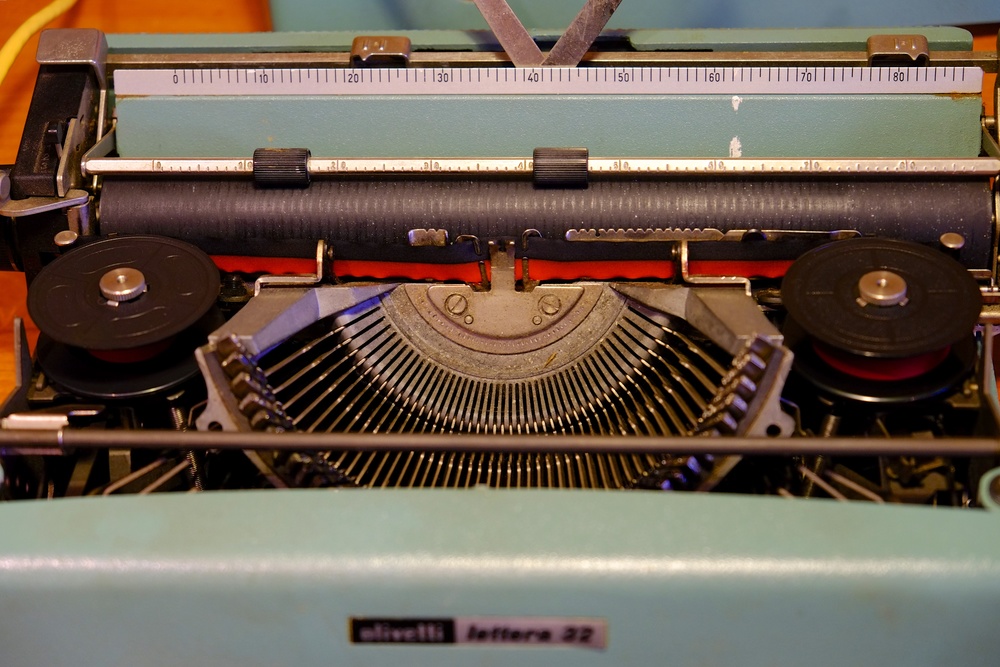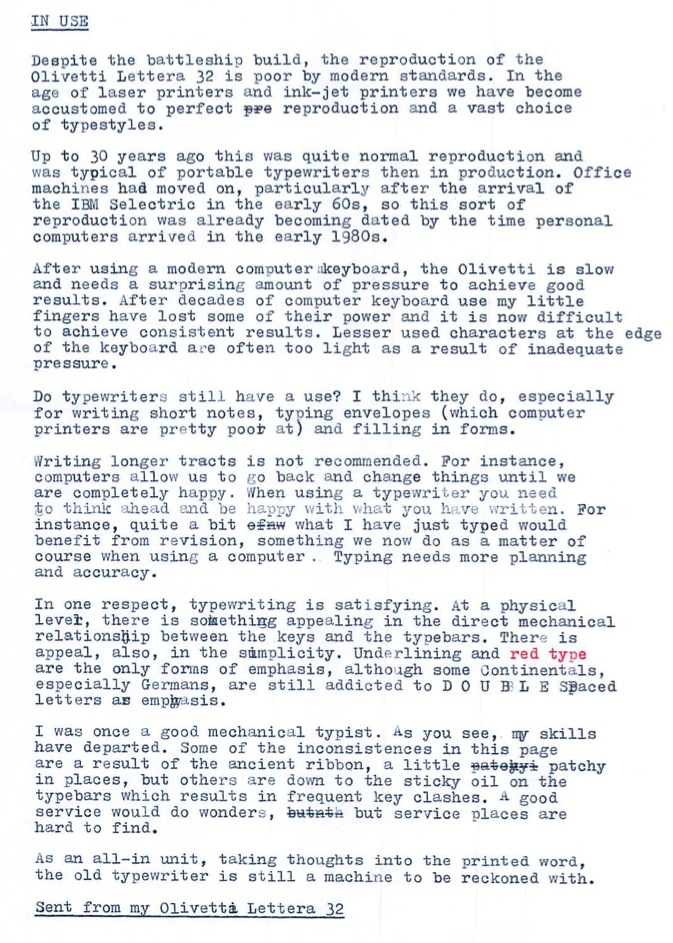During a periodic ferret among the junk in my garage I uncovered two ancient portable typewriters, an Olivetta Lettera 32 and an Olympia Traveller de Luxe, both from the late 1960s or early 1970s. Memories came flooding back, so I dusted off the cases and put them to work. Miraculously, after 20 years buried among junk, both were in reasonable working order and, in the case of the Olivetti, the fabric ink ribbon still had some life left in it. Just what I need, I thought, to type some envelopes and Christmas thank-you notes.

Seeing these two machines on the desk reminded me that before 1980 they were the nearest thing we had to laptop computers. We now slip a tiny MacBook Air into our bags and set off for the day. Before the age of the personal computer these heavy portable typewriters were all we had if we wanted to be productive out of the office. Portable they might be, but I wouldn’t dare set one up in Starbucks because the noise would have me thrown out.
Memory lane
Looking at the two portables I immediately recognised the dilemma of choosing between them. That’s probably why I kept both. The Olivetti is build like a brick out-house and will last a lifetime. But, as I reminded myself, the typed line is uneven and less appealing than the results from the Olympia.
Lettera 32
Since The Olivetti has ink and can be used immediately, I thought I’d review it first. How does it compare with a modern laptop?
As one-trick ponies go, the Lettera 32 is a pretty fine example of 1960s-style productivity. It was the last and probably the most advanced in a long line of portable typewriters stretching right back to the beginning of the 20th century. Not much changed mechanically in 70 years and the Olivetti was perfection in its day. It was one of the flattest, smallest and strongest portables ever made.
All Lettera 32s came in a light greeny blue teal colour and had a crinkle finish which was an improvement on the smooth-finish Lettera 22. They were made in Italy and Spain and some connoisseurs reckon the Italian job was better all round. Mine is Spanish, so I am not sure about this because I have no comparison.
Chassis
This chassis is solidsville. It is sleek and has extremely clean lines. In fact, it still looks pretty modern despite the 50-year-old design (by Marcello Nizolli). Because all the moving parts are enclosed, especially by a bottom plate, the machine can be used just as effectively on the lap as on a desk. It is probably the original laptop.
Keyboard
The black plastic keytops have nice finger indents and are labelled clearly in what appears to be embedded plastic letters. There is no sign that symbols have been stencilled on, as we see on many cheaper computer keyboards. After 40 years the keys on my machine are like new, with a nice patina of wear on the most popular letters. Q, Z some of the less-frequently used characters are a bit grimy, but it is more or less what you would see on a well-used computer keyboard.
With admirable prescience, this 1960s Olivetti featured an @ key, decades before it appeared in email addresses. I jest, of course, because all typewriters had an @ key. The symbol was used as an abbreviation for “at” in accounting. Neglected by decades of typists, the poor old @ has been given a new lease of life thanks to email and is now one of the most used symbols in the world. Millions, if not billions, have no idea it is pronounced “at” but they know what it does. My many Greek friends pronounce it papaki, little duck, because that’s what it looks like.
An oddity of the Olivetti (unlike the Olympia) is the lack of a figure 1. Instead, the top row of keys begins with 2 and you have to use a small L for the figure. I never liked this and, stranglely, it was one of my biggest criticisms of the Olivetti. At least there is a zero. Early typewriters had no 1 and no zero, instead relying on a small L and a capital O.
The controls included in the keyboard unit are minimal. On the left, next to the 2, there is a margin-release key (unmarked)and a small lever to set tabs. To the right is a three-position lever to select black or red type or to switch off the ribbon to enable stencil cutting. Stencils were an onion-skin sheet with paper backing which could be prepared on the typewriter and then used to produce multiple copies on a Roneo or Gestetner duplicor. Ink was forced through the impressions left by the typewriter keys so that the words could be printed on paper.
Also on the right of the keyboard is a backspace key, clearly marked with a left-pointing arrow, and a red tab key. This could move the paper to preset tab positions. As with all mechanical typewriters, the Olivetti has equal letter spacing so it was very easy to set up tabbed forms. Usually typewriters were available in two font sizes, Pica at 10 characters per inch (as on this Olivetti) or smaller Elite at 12 characters per inch.


Carriage
The moveable carriage, as on all typwriters, features a hard rubber cylinder (the platen) to act as a backing for the paper. The paper is fed in from the top and then straighened and aligned for the first typing line. There are pica scales at the back of the carriage and on the retaining bar, which also contains two rubber rollers to keep the paper flat against the platen. At either end of the carriage are knurled knobs to move the paper up and down one line at a time.
Portables such as the Olivetti had a smaller diameter platen than office machines and, as a result, manipulation of thicker paper and envelopes could present problems. Especially with envelopes, there is a tendency for the feed to slip and this means a manual adjustment of the typing line.
The carriage has further controls to asist with paper handling. On the left is a four-position lever to allow selection of line spacing (0,1,2,3) while on the right is a paper release lever which allows the paper to be extracted or aligned. On either end of the carriage are release levers to allow the carriage to be moved rapidly left or right.
Finally, on the left of the carriage is the return lever. This simultaneously unlocks the carriage and moves the carriage to the right, thus positioning the type guide to the left in readiness for the next line. The lever also advances the line spacing according to the setting on the line-space lever. When electric typewriters were introduced there was no longer a need for the return lever. Instead, the now familiar return key appeared in the position we find it on computer keyboards.
Under the hood
In common with all later mechanical typewriters, the Olivetti features a crescent of type bars, one corresponding to every key on the board and mechanically linked to that key. This is known as the type basket. The type head of every bar contains two characters, one lower case, one upper case. Above the type basket is the ribbon mechanism guiding the inked fabric ribbon. On every key press the ribbon advances from one spool to the other, in tenths of an inch increments, automatically reversing when the end is reached. This ensures efficient use of the entire ribbon as it gradually wears out.
If a two-colour ribbon is fitted, as on the Lettera 32 in the pictures, the black is positioned at the bottom since this is the normal position for the type bars to hit the paper. The alternative colour, usually red, can be selected by lever and, in this case, the ribbon holder moves upwards to expose the bottom half of the ribbon to the type heads. Scrooges among us would buy all-black ribbons and then reverse them to use the virgin other half when the bottom bit was threadbare.
The shift, to select upper case and top-level symbols, is mechanically selected by keys situated in the same positions as the shift key on a computer keyboard. There were two methods of achieving this adjustment. In the case of the Olivetti, pressing shift results in the entire typebasket moving down. The Olympia, in common with many portable typewriters of the day (and early century office machines), uses the alternative method of raising the carriage instead of lowering the type basket. The Olivetti system is more accurate and needs less pressure on the shift keys. As a result, the Olivetti presents fewer instances of half-shift capitals.
As on modern keyboards, there is a shift lock on the lefthand side, above the shift key. This is a good old-fashioned mechanical lock, of course.
Back in business
I have enjoyed my week’s outing with the Olivetti. For short notes, as I explain above, a little typewriter still has a purpose. Ribbons for these old machines are as rare as rocking horse manure, so I resorted to Amazon and paid through the nose for Olivetti and Olympia ribbons. They will arrive next week and, I hope, will transform both machines into useful tools. I am especially looking forward to trying the Olympia because, as I remember, it was my favourite and produced better results than the Olivetti. I will post an update when I have done more typing.
More reading
If you have enjoyed this you might like to read my article on office life in the 1960s and the sequel, office life in the 1970s. For another view on the Olivetti Lettera 32, see this article.
by Mike Evans, 25 December 2012


